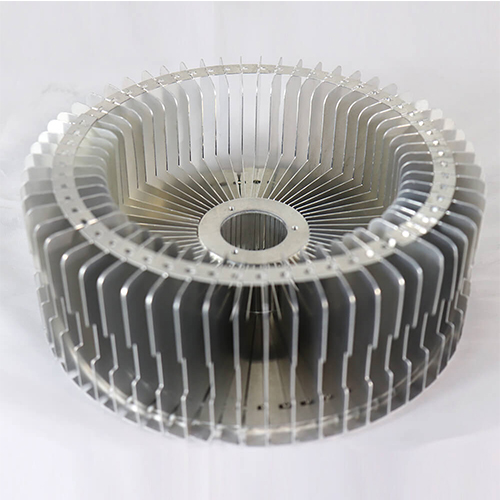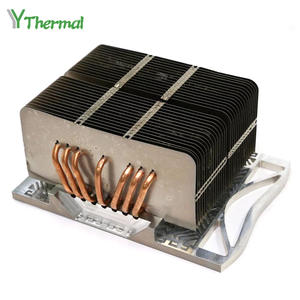
Summer is here, and the temperature of the room and the computer has risen sharply. Maybe some of my friends' computers have "hummed" like a helicopter! Today, I mainly pass some easy-to-understand knowledge points to popularize the knowledge of CPU round heat sink selection. I hope that when my friends choose air-cooled radiators, they can roughly know how to look good or bad!

How about the CPU air cooling radiator? Air-cooled radiator purchase knowledge literacy
At present, CPU coolers are mainly divided into air cooling and water cooling, among which air cooling is the absolute mainstream, and water cooling is mainly used by a small number of high-end players. Now, let's talk about the importance of CPU cooler first.
If the computer has poor heat dissipation and the temperature of the CPU is too high, the CPU will automatically reduce the frequency to reduce heat in order to protect itself from being burned out, which will cause the performance of the computer to decline. Secondly, if the temperature is still too high after the frequency reduction, the CPU will automatically trigger the computer to crash to protect itself, so it is necessary to ensure good heat dissipation.
First, the working principle of the air-cooled radiator
The heat transfer base is in close contact with the CPU, and the heat generated by the CPU is conducted to the heat dissipation fins through the heat conduction device, and then the heat on the fins is blown away by the fan.
There are three types of heat conduction devices:
1. Pure copper (pure aluminum) heat conduction: This method has low thermal conductivity, but the structure is simple and the price is cheap. Many original radiators use this method.
2. Conducting copper tube: This is the most commonly used method now. Its copper tube is hollow and filled with a heat-conducting liquid. When the temperature rises, the liquid at the bottom of the copper tube evaporates and absorbs heat, and transfers the heat to the cooling fins. The lowering condenses into a liquid and flows back to the bottom of the copper tube, so that the heat conduction efficiency is very high. So most radiators these days are this way.
3. Water: It is the water-cooled radiator we often say. Strictly speaking, it is not water, but a liquid with high thermal conductivity. It takes the heat of the CPU away through water, and then the high-temperature water is blown away by the fan when it passes through the tortuous cold radiator (the structure is similar to the radiator at home), and becomes cold water and circulates again.
Second. Factors affecting the cooling effect of air cooling
Efficiency of heat transfer: The efficiency of heat transfer is the key to heat dissipation. There are four factors that affect the efficiency of heat transfer.
1. The number and thickness of heat pipes: the more heat pipes, the better, generally 2 are just enough, 4 are enough, and 6 or more are high-end radiators; the thicker the copper pipes, the better (most of them are 6mm, and some are 8mm) of).
2. Process of heat transfer base:
1). Heat pipe direct contact: The base of this scheme is very common, and the general radiators of 100 yuan and below are of this type. In this solution, in order to ensure the flatness of the contact surface with the CPU, the copper tube will be flattened and polished, which makes the already thin copper tube thinner, and unevenness will appear over time, affecting the thermal conductivity. Regular manufacturers will polish the copper tube very flat, so that the contact area with the CPU is larger and the heat conduction efficiency is high. The copper pipes of some copycat manufacturers are uneven, so that some copper pipes cannot touch the CPU at all when they are working, so no amount of copper pipes is just a shelf.
2). Copper bottom welding (mirror polishing): The base price of this solution is slightly more expensive, because the heat transfer base is directly made into a mirror surface, the contact area is higher, and the thermal conductivity is better. Therefore, mid-to-high-end air-cooled radiators use this scheme.
3). Vaporizing plate: This is a rarely seen solution. The principle is similar to a heat pipe. It also transfers heat by evaporating the liquid when it is heated and then liquefying when it is cold. This solution has high uniform heat conduction and high efficiency, but high cost , so it is rare.
3. Thermal grease: Due to the manufacturing process, it is impossible to have a completely flat contact surface between the radiator base and the CPU (even if you look flat, you can see the unevenness under a magnifying glass), so it is necessary to Apply a layer of silicone grease with a higher thermal conductivity to fill in these uneven areas to help conduct heat. The thermal conductivity of silicone grease is much lower than that of copper, so as long as a thin layer is evenly applied, if it is applied too thickly, it will affect the heat dissipation.
The thermal conductivity of general silicone grease is between 5-8, and there are also very expensive thermal conductivity of 10-15.
4. The process of the junction between the heat dissipation fin and the heat pipe: the heat pipe is interspersed between the fins, and the heat needs to be transferred to the fins, so the treatment process of the place where they meet will also affect the thermal conductivity. There are two current treatment processes. :
1). Reflow soldering: As the name suggests, it is to solder the two together. This solution has a high cost, but has good thermal conductivity and is very firm, and it is not easy for the fins to loosen.
2). Wearing fin: Also called "wearing piece" process. As the name implies, holes are made on the fins, and then the heat-conducting copper tubes are inserted into the fins with the help of external force. The cost of this process is low, although it is simple, but it is not easy to do well, because problems such as poor contact and loose fins must be considered (if you flip it at will, the fins will slide on the heat pipe, and the heat conduction effect can be imagined and know).
5. The size of the contact area between the fins and the air
The fins are responsible for heat dissipation. Its task is to dissipate the led heat sink sent by the heat pipe into the air, so the fins must be in contact with the air as much as possible. Some manufacturers will carefully design some bumps to make them as large as possible. Increase the surface area of the fins.
6. Air volume
Air volume represents the total volume of air that the fan can send out per minute, generally expressed in CFM. The larger the air volume, the better the heat dissipation.
The parameters of the fan include: speed, wind pressure, fan blade size, noise, etc. Most of the fans now have PWM intelligent speed regulation, and what we need to pay attention to is the air volume, noise, etc.
Three. the type of air-cooled radiator
There are three types of air-cooled radiators: passive cooling (fanless design), tower type, and push-down type.
What are the advantages and disadvantages of these three, and how to choose!
1. Passive heat dissipation: It is actually a fanless heat sink in computer, which relies on air circulation to take away the heat on the fins. Pros: No noise at all. Disadvantages: poor heat dissipation, suitable for platforms with very low heat generation (almost all of our mobile phones are passively dissipated, even not as good as passive heat dissipation).
2. Press-down heat dissipation: This radiator fan blows downward, so it can also take care of the heat dissipation of the motherboard and memory modules while taking into account the heat dissipation of the CPU. However, the heat dissipation effect is slightly poor, and it will disturb the air duct of the chassis, so it is suitable for platforms with low heat generation. At the same time, because of its small size and no space, it is a good news for small chassis.

3. Tower cooling: This radiator stands tall like a tower, hence the name tower cooling. This radiator blows air in one direction without disturbing the air duct, and the fins and fans can be made relatively large, so the heat dissipation performance is the best. However, it cannot take into account the heat dissipation of the motherboard and the memory, so the fan on the chassis is often assisted.